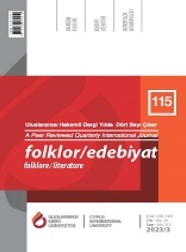Speculative Fiction and Pattern Recognition: Narrative Models for a Retrained Intuition
Speculative Fiction and Pattern Recognition: Narrative Models for a Retrained Intuition
Author(s): Berkay ÜstünSubject(s): Comparative Study of Literature, Cognitive Psychology, Theory of Literature, British Literature, American Literature
Published by: Uluslararası Kıbrıs Üniversitesi
Keywords: Concrete; abstract; pattern recognition; abductive inference; intuition;
Summary/Abstract: The notion of pattern recognition emerged in the late 1950s as an extension of advances in cybernetics and information theory. From the start, authors of science fiction and speculative fiction narratives made their own explorations of the concept, taking it to fields and extremes not predicted by the state of development of pattern recognition technologies. I argue that a pair of these narratives provide opportunities to observe the development of a public understanding of, and imaginaries deriving from, a vision of perception geared toward patterns, arrangements, and configurations that involve historical change. More specifically, these narratives stage questions of historical meaning and intuitive grasp of patterns of consumer behavior by modifying the notion they borrow from computational research through the intermediary of media theory. A second goal of the article is to examine literary history by taking the relevant works of Brunner and Gibson as favorable cases for observing the beginnings and transformations of the reception of pattern recognition concept by speculative fiction. The common reference they make to historical concretion serves as a constant across their differences here. Both fictions seem to stage the possibilities of pattern literacy as a human capacity that includes but is not reducible to one of its most famous and problematic avatars, which is that of a sense of conspiracy, belief gone awry, and/or paranoia (which, according to Fredric Jameson, is the “poor person’s cognitive mapping’’). Methodologically relying on a combination of media theory and close readings, the goal here is to ascertain whether such fictions constitute viable cases for a “pattern recognition from below”, as distinct from a data-intensive pursuit. In this sense, this study neither constitutes an intellectual history of pattern recognition that reduces the object of its study to mere accouterments of context nor simply a close reading of each of the texts on their own terms. It is a comparative exercise that aims to gain surplus of historical and textual intelligibility through the juxtaposition of its chronologically distant narratives. From different angles, the two close readings treat the same core problem of the possibility to retain an affirmative approach to the historical-morphological possibilities inherent in pattern recognition and not consign it to an “ideology” of the information society.
Journal: Folklor/Edebiyat
- Issue Year: 29/2023
- Issue No: 115
- Page Range: 869-886
- Page Count: 18
- Language: English

